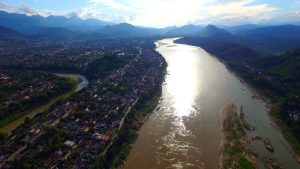Last week marked five years since the 1,285-MW Xayaburi Hydropower Dam began commercial operations. Xayaburi was the first major hydropower project to be developed in Laos on the mainstream Mekong River. Though heralded by its proponents as a supposedly “transparent” and “community-centered” dam that could export “green” power from Laos to Thailand, the reality witnessed by the public on both sides of the river stands in stark contrast to these promises.
Local Thai and Lao people alike have reported a drastic decrease in fish populations, creating economic hardship due to the drop in related local income generation. They have also noted major fluctuations in the level and flow of the river, which has led to riverbank erosion and made it nearly impossible for families to grow subsistence crops along the riverside. Times when the water turns visibly blue, devoid of fertile sediments that would otherwise flow downstream to replenish soils for growing food, have been reported widely by local media.
Meanwhile, the public has been left in the dark about the actual impacts of the project. No verifiable assessments have been publicly released about changes to migratory fish populations, sediment loads, or water flow. Nor has there been any qualitative data collated to account for the sheer social and economic losses to Thai and Lao communities not only around the site but also upstream and downstream. In the meantime, the developers continue to profit, while the electricity bills of the average household in Thailand – the destination of most of the power generated by Xayaburi – are rising.
Rather than take stock of the actual transboundary impacts of the Xayaburi dam on the economic, social and environmental well-being of Mekong communities, these same developers, in partnership with government officials in Vientiane, are bulldozing ahead with multi-decade power purchase agreements for three more large dam projects on the Mekong: Pak Beng, Luang Prabang, and Pak Lay. They are also pursuing development plans for four others. Some argue that the energy generated by this build-out could be channeled to feed a yet-to-be-developed regional power system, starting by transmitting power from Laos – a country where, according to the UNDP, approximately 45 percent of the population is considered to experience or be vulnerable to multidimensional poverty – to Singapore via Thailand.
Residents of Singapore are being sold the idea that this arrangement could bring “win-win” benefits in the race to shift away from fossil-fuel-dependent energy. But for whom is this a winning deal, and at what cost?
For consumers, power generated by dams and transported across hundreds of kilometers is now substantively more expensive than other low-cost, low-impact alternatives, such as rooftop and stacked solar systems, as documented and reported by the International Renewable Energy Agency. Sourcing energy from hydropower dams cannot be considered low-carbon, as it destroys the natural absorption of carbon by free-flowing river systems and surrounding ecosystems, while generating methane and carbon dioxide emissions when vegetation and organic matter are flooded in the reservoirs and start to decay underwater, as well as when areas are deforested to make way for building the project.
In the midst of the climate crisis, both during periods of drought or flooding, dams can be rendered non-functional. The displacement of communities and loss of livelihoods to make way for dams, also means this arrangement directly damages peoples’ rights to a livelihood and a healthy environment along the Mekong River, entrenching rather than alleviating economic disparity.
In response, Mekong-based community groups, indigenous peoples’ networks. and allied advocacy organizations are coordinating across borders to take every opportunity possible to bring attention to the irreversible social, economic, and ecological losses that will arise if more dams are built in Laos, and to put forward alternative options for power sector development. This has included filing legal cases, joining and speaking out during parliamentary hearings, organizing gatherings along the river, highlighting issues to the Thai government ombudsman, and using both national and international arenas to urge dam project proponents’ compliance with human rights frameworks.
Most recently, following submissions made by a coalition of civil society groups to the Thai National Human Rights Commission (NHRC) about the transboundary human rights impacts of Mekong dams, the NHRC concluded that the development of four more dams on the Mekong “are at risk of violating the human rights of the Thai people and Thailand’s sovereignty.” It issued a firm warning, calling on the Thai government to undertake appropriate studies on the cumulative impacts that have occurred since the construction of the Xayaburi Dam and urging consideration of “other alternative energy sources that do not cause social and environmental impacts and do not violate human rights.” It also emphasized the responsibility of hydropower project developers and investors to act in accordance with the U.N. Guiding Principles on Human Rights.
Mekong communities are taking a stand for intergenerational justice – to keep the Mekong River flowing and ensure the millions who depend upon it can thrive. The question now is whether residents of Singapore – as the proposed consumers of power generated by Mekong dams – are also prepared to challenge the necessity of a model that not only depends upon outdated climate science, but also the dislocation and dispossession of some of the most marginalized people in the region.

































